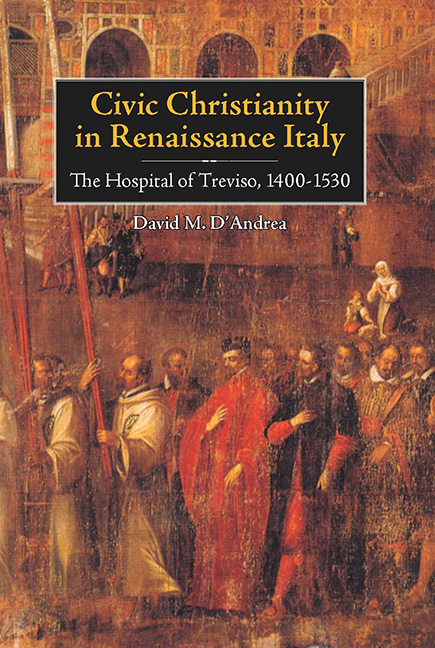Book contents
- Frontmatter
- Contents
- List of Illustrations
- Acknowledgments
- List of Abbreviations
- Notes to the Reader
- Introduction
- Chapter 1 The City of God
- Chapter 2 The Confraternal Family
- Chapter 3 The Bonds and Bounds of Charity
- Chapter 4 Medical Care and Public Health
- Chapter 5 Instruction for This Life and the Next
- Chapter 6 Crisis and Reform
- Notes
- Bibliography
- Index
Chapter 3 - The Bonds and Bounds of Charity
Published online by Cambridge University Press: 08 April 2017
- Frontmatter
- Contents
- List of Illustrations
- Acknowledgments
- List of Abbreviations
- Notes to the Reader
- Introduction
- Chapter 1 The City of God
- Chapter 2 The Confraternal Family
- Chapter 3 The Bonds and Bounds of Charity
- Chapter 4 Medical Care and Public Health
- Chapter 5 Instruction for This Life and the Next
- Chapter 6 Crisis and Reform
- Notes
- Bibliography
- Index
Summary
Then the King will say to the people on his right: “You who are blessed by my Father: come! Come and receive the kingdom which has been prepared for you ever since the creation of the world. I was hungry and you fed me, thirsty and you gave me drink; I was a stranger and you received me in your homes, naked and you clothed me; I was sick and you took care of me, in prison and you visited me.”
—Matthew 25: 34–37
“Take hold of that blaspheming swindler! He comes here pretending to be a cripple, poking fun at our Saint and making fools of us when he wasn't really crippled at all!”
And so saying, [the Trevisans] seized him and dragged him away; then they took him by the hair, tore every stitch of clothing from his back, and started to punch and to kick him.
—Boccaccio, The Decameron, Second Day, First Story: the tale of Martellino, who pretended to be paralyzed and healed by a local saint in Treviso
Matthew's description of the Last Judgment and Boccaccio's tale of the Trevisan response to the charlatan Martellino's deception introduce us to the major themes of this chapter: the desire to give charity to needy persons, tempered by the necessity of deciding who truly deserved help; the types of aid to provide; and the ways of administering the assistance. Charitable institutions bound communities together with a network of gifts and support systems. John Bossy argues that “the state of charity, meaning social integration, was the principal end of the Christian life, and any people that claimed to be Christian must embody it somehow, at some time, in this world.”1 An investigation of Santa Maria dei Battuti's works of charity will reveal how the Trevisan community reconciled Christian ideals and social realities. The confraternity provided charity designed to relieve the sufferings of the poor: ad hoc relief, annual almsgiving, assistance to prisoners, and debt remission. The care of foundlings and orphans also constituted a large part of the brotherhood's charitable activities, which included nursing, training, and ultimately reintroducing the child into society. The universal Christian community also benefited from the confraternity's gifts to support religious rites, ecclesiastical houses, newly converted Christians, and pilgrims. In all of its activities, the confraternity desired to assist those worthy of aid and avoid abuse or overuse of its generosity.
- Type
- Chapter
- Information
- Civic Christianity in Renaissance ItalyThe Hospital of Treviso, 1400–1530, pp. 58 - 84Publisher: Boydell & BrewerPrint publication year: 2007



